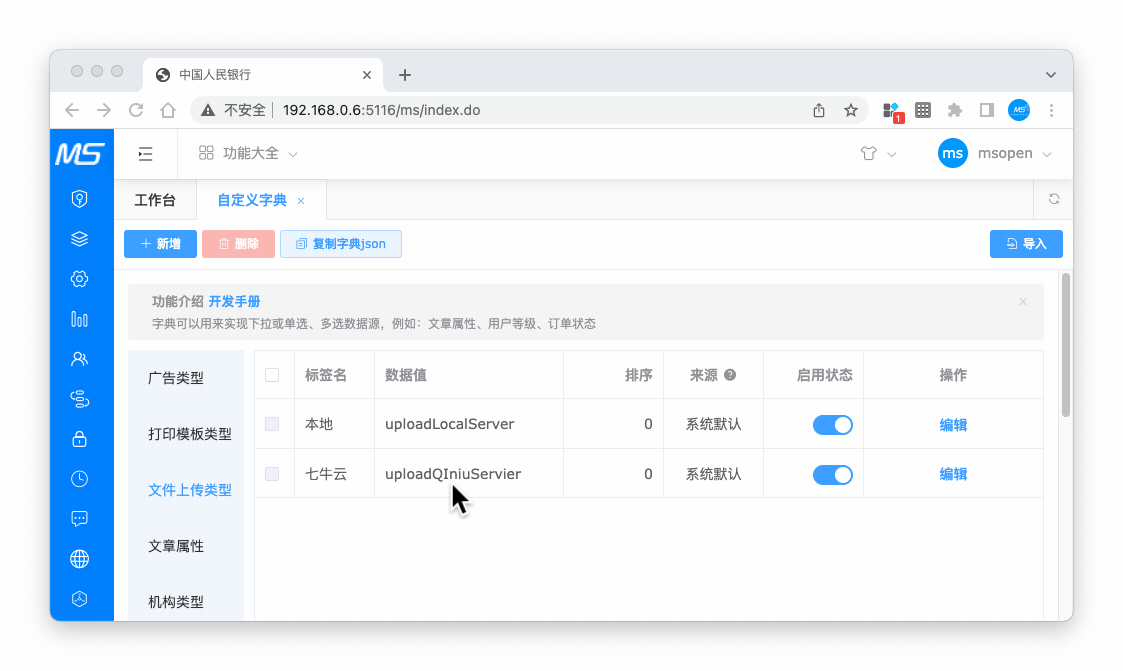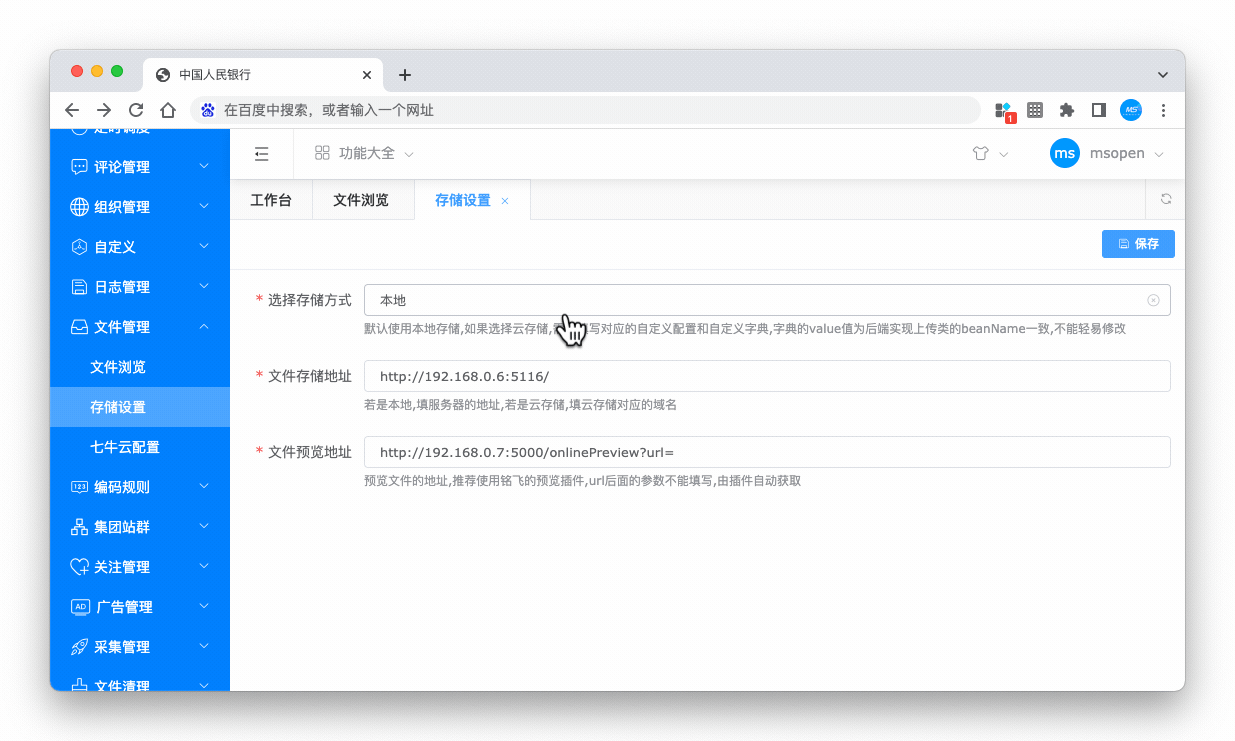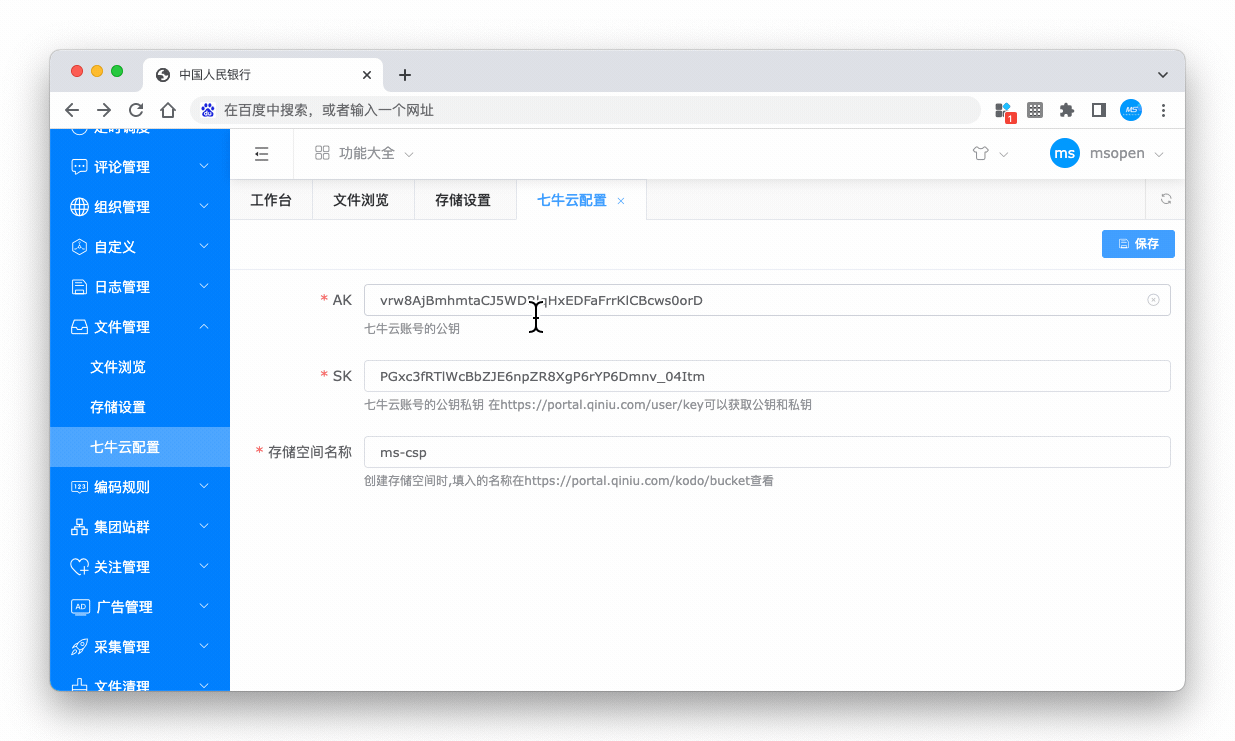1. 业务开发
默认采用分片上传设计,开发者只需要在自己的业务中关心抽象类返回的状态码是什么。 状态码分为三类:200表示所有分片上传完毕,返回值是文件地址(相对路径);206表示分片上传成功,返回值为当前总分片数;500表示上传失败。其余情况均抛出异常处理。
1.1. 扩展第三方云存储
默认集成了七牛云存储。
集成第三方接口步骤:
1、新建对应云存储类,并继承IUploadChunkService类,重写upload方法及checkFileIfExist方法,自定义一个 beanName 名称
2、 配置文件上传类型,打开菜单 自定义->自定义字典->文件上传类型 添加字典,标签名为 '存储类型' ,值为存储类的beanName,如:七牛云 uploadQiNiuService
3、 修改存储配置,打开菜单 文件管理->存储设置下拉选择存储方式 ;
1.2. 七牛云范例
1.2.1. 创建存储类 UploadQiNiuServiceImpl
/**
* 七牛云的上传实现类
*/
@Service("uploadQiNiuService")
public class UploadQiNiuServiceImpl extends IUploadChunkService {
@Override
public ResultData upload(UploadConfigBean bean) {
ResultData resultData = super.upload(bean);
// 分片未上传完毕则返回
if (resultData.getCode()!= HttpStatus.OK.value()){
return resultData;
}
LOG.debug("七牛云上传实现");
String targetFile = resultData.getData(String.class);
try {
ImageUtil.imgWatermark(targetFile);
} catch (IOException e) {
LOG.debug("水印添加失败");
e.printStackTrace();
}
/**
* 获取七牛云配置
*/
Map<String,String> map = ConfigUtil.getMap("七牛云配置");
String qiniuAk = map.get("qiniuAk");
String qiniuSk = map.get("qiniuSk");
String qiniuDomain = map.get("qiniuDomain");
String bucketName = map.get("bucketName");
if(!qiniuDomain.endsWith("/")){
qiniuDomain += "/";
}
String uploadPath = ConfigUtil.getString(Const.CONFIG_UPLOAD, "uploadPath", "upload");
// 判断配置的上传路径是否绝对路径
boolean isReal = new File(uploadPath).isAbsolute();
String uploadMapping = ConfigUtil.getString(Const.CONFIG_UPLOAD, "uploadMapping", "/upload/**");
targetFile = targetFile.replace(uploadMapping.replace("**", ""), "");
if(isReal) {
//源图片
targetFile = uploadPath+"/"+targetFile.replace(uploadMapping.replace("**", ""), "");
} else {
targetFile = BasicUtil.getRealPath(uploadPath + File.separator +targetFile.replace(uploadMapping.replace("**", ""), ""));
}
/**
* 七牛云上传逻辑
*/
//构造一个带指定 Region 对象的配置类
Configuration cfg = new Configuration(Region.autoRegion());
//...其他参数参考类注释
UploadManager uploadManager = new UploadManager(cfg);
//...生成上传凭证,然后准备上传
String accessKey = qiniuAk;
String secretKey = qiniuSk;
String bucket = bucketName;
//默认不指定key的情况下,以文件内容的hash值作为文件名
String key = bean.getFileName();
String filePath = null;
InputStream inputStream = FileUtil.getInputStream(targetFile);
Auth auth = Auth.create(accessKey, secretKey);
String upToken = auth.uploadToken(bucket);
try {
Response response = uploadManager.put(inputStream,key,upToken,null, null);
//解析上传成功的结果
DefaultPutRet putRet = new Gson().fromJson(response.bodyString(), DefaultPutRet.class);
filePath = qiniuDomain + putRet.key;
System.out.println("完整文件路径:\t"+ filePath);
} catch (QiniuException ex) {
Response r = ex.response;
System.err.println(r.toString());
try {
System.err.println(r.bodyString());
} catch (QiniuException ex2) {
//ignore
}
}
// 清除本地服务器文件
if (FileUtil.file(targetFile).exists()){
FileUtil.del(targetFile);
}
return ResultData.build().success(filePath);
}
@Override
public boolean checkFileIfExist(String realPath) {
//构造一个带指定 Region 对象的配置类
Configuration cfg = new Configuration(Region.region0());
//...其他参数参考类注释
Map<String,String> map = ConfigUtil.getMap("七牛云配置");
String qiniuAk = map.get("qiniuAk");
String qiniuSk = map.get("qiniuSk");
String bucketName = map.get("bucketName");
String key = FileUtil.getName(realPath);
Auth auth = Auth.create(qiniuAk, qiniuSk);
BucketManager bucketManager = new BucketManager(auth, cfg);
try {
FileInfo fileInfo = bucketManager.stat(bucketName, key);
LOG.debug(fileInfo.md5);
// todo 判断方式
return StringUtils.isNotBlank(fileInfo.md5);
} catch (QiniuException ex) {
System.err.println(ex.response.toString());
}
return false;
}
}
[!tip] 代码中的七牛云配置信息通过自定义配置实现
beanName 名称为 uploadQiNiuService
1.2.2. 配置文件上传类型 字典
1.2.3. 存储设置
[!tip] 通过自定义配置实现


